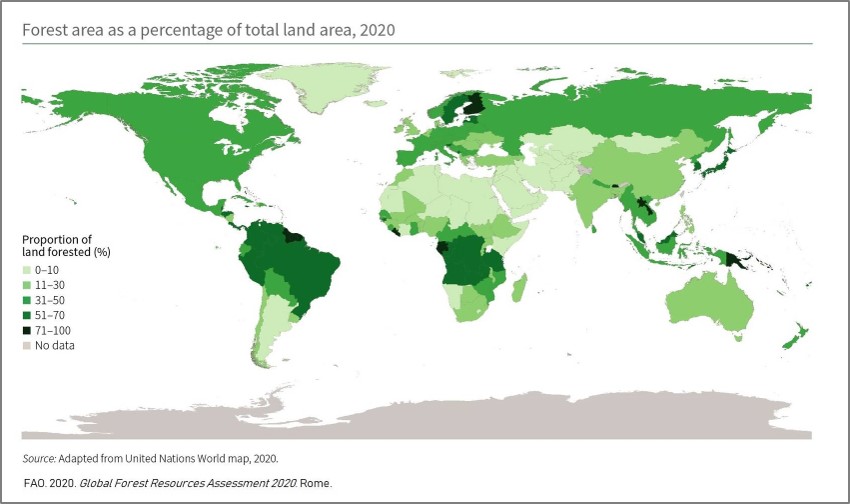2. Resources for the bioeconomy
Lignocellulosic plants
Structure and composition
Starch is chemically converted by plants into other required reserve substances (fats and proteins) or secondary plant substances (tannins, alkaloids or essential oils) as required. These secondary plant substances are also very interesting for the bioeconomy and are therefore described in more detail in the chapter on plant-based medicines. Lignin is another such secondary plant substance. Perennial plants store it in their cell walls for stabilization. Because of this structural tissue of lignin and cellulose, they are referred to as lignocellulosic plants. The respective proportion of cellulose, hemicellulose and lignin depends on the species and the site conditions. The following table provides an overview of the composition and properties of important lignocellulosic plants.
|
Plant |
Cellulose |
Hemicellulose |
Lignin |
Ash |
Water content |
Heating value |
|
|
(% DM) |
(% DM) |
(% DM) |
(%) |
(% FM) |
(MJ/kg) |
|
Miscanthus |
44-57 |
16-30 |
8-22 |
1-9 |
3-49 |
15-21 |
|
Reed canary grass |
26-39 |
17-28 |
4-5 |
2-13 |
7-65 |
16-20 |
|
Elephant grass |
34-42 |
20-23 |
8-24 |
6-10 |
74 |
18 |
|
Common reed |
34-38 |
21-28 |
19-23 |
3-8 |
16 |
14-15 |
|
Giant reed |
31-39 |
21-35 |
18-23 |
3-6 |
36-42 |
14-15 |
|
Switchgrass |
30-45 |
21-35 |
5-23 |
2-10 |
8-15 |
17-19 |
|
Sugarcane |
34-42 |
29-43 |
19-21 |
2-12 |
6-50 |
17-18 |
|
Wheat straw |
29-52 |
11-39 |
8-30 |
1-19 |
10-17 |
15-21 |
|
Maize straw |
28-51 |
19-30 |
11-17 |
4-10 |
5-6 |
17-19 |
|
Softwood |
35-83 |
8-42 |
12-43 |
1-6 |
0-63 |
16-24 |
|
Hardwood |
28-50 |
18-39 |
13-28 |
0.2-5 |
2-48 |
15-21 |
|
Energy forestry (poplar, willow) |
35-80 |
13-42 |
15-32 |
0.2-5 |
2-50 |
17-20 |
DM: Dry mass; FM: Fresh mass
Forest wood
Forestry is an important supplier of economically significant quantities of lignocellulose raw materials. The world's forests produce wood as building and construction materials, for pulp and paper production and for energy generation. Wood is one of the most important bio-based resources used by humans and has been used for a wide variety of applications for thousands of years.
Humans manage a large proportion of the world's forests. Primeval forests as defined by the FAO still exist on 1.11 billion hectares, which is approx. 27 % of the total forest area (4.06 billion hectares), covering approx. 31 % of the global land area. The largest shares of forest areas are located in tropical (45 %) and boreal (27 %) zones of the earth (FAO 2020). The following figure shows the proportion of forest area in relation to the total area of the individual countries of the world.

- Sowing, planting or promoting natural regeneration
- Pruning, thinning or branching to reduce stand density and improve the quality of the remaining trees
- Harvesting measures
The harvested logs can be divided into roundwood, industrial wood and pulpwood, which are primarily processed in the forestry industry. Not all parts of the tree are sold to the wood and paper processing industry. In most cases, weak tree parts, branches and the crown remain in the forest (residual forest wood) and serve as fertilizer for the forest soil after rotting. Increasingly, however, these assortments are also of interest to the energy industry. They are often used as firewood or are also of interest for biorefineries. However, care should be taken to ensure that sufficient residual wood remains in the forest for the supply of nutrients and for other ecological reasons (e.g. biodiversity).
The wood processing industry is strongly oriented towards softwood, as it grows predominantly straight and fast and has good properties for building and construction applications due to its lower density and simultaneous tensile and bending strength. Hardwood is often used in furniture construction and interior fittings. But even there, chipboard and fiberboard made from inferior softwood grades are increasingly being used for cost reasons and to reduce weight.
Around 1.4 billion m³ of softwood logs and 2.5 billion m³ of hardwood were harvested worldwide in 2020 (FAOSTAT 2023).
Around 117 million m3 of wood grows in German forests every year (bwi.info). To get a better idea of how much this is, a wooden cube is often used to visualize the growth of wood per second. For Germany, this cube would have an edge length of 1.55 meters.

In some regions, trees are mainly grown in plantations. In South America, plantations account for 99 % of planted forests (FAO definition of “Planted Forests”), whereas in Europe they account for just 6 % (FAO 2020). A plantation is usually established with only one tree species, at the same age and in a regular arrangement and is usually used for the rapid production of wood for fiber (for pulp production) or energy production (FAO definition).
Lignocellulosic biomass can also be supplied from agricultural or landcare waste streams, as well as from industry or demolition materials.
Lignocellulosic biomass is often considered a promising feedstock for biofuel production as it is an abundant source of organic material that is not in direct competition with food and feed. The lignocellulosic molecules can be cracked in an oxygen-free atmosphere by pyrolysis, they can be gasified and then liquefied using a Fischer-Tropsch synthesis, or they can be converted to sugar and then to alcohol.